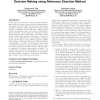276 search results - page 50 / 56 » A control theoretic approach to noncooperative game design |
TMC
2010
13 years 5 months ago
2010
—In wireless networks, node cooperation has been exploited as a data relaying mechanism for decades. However, the wireless channel allows for much richer interaction among nodes....
CDC
2010
IEEE
13 years 2 months ago
2010
IEEE
The distributed estimation of the number of active sensors in a network can be important for estimation and organization purposes. We propose a design methodology based on the foll...
EUROMICRO
2002
IEEE
14 years 14 days ago
2002
IEEE
To accommodate heterogeneous transmission conditions in a streaming scenario several multi-rate multicast solutions have been proposed, based on simulcasting or hierarchical layer...
GECCO
2007
Springer
14 years 1 months ago
2007
Springer
In this paper, we borrow the concept of reference direction approach from the multi-criterion decision-making literature and combine it with an EMO procedure to develop an algorit...
ATAL
2005
Springer
14 years 1 months ago
2005
Springer
Reinforcement learning problems are commonly tackled with temporal difference methods, which use dynamic programming and statistical sampling to estimate the long-term value of ta...

